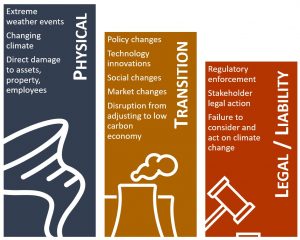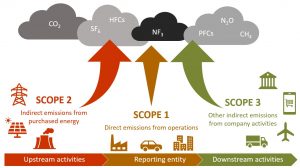A number of countries have made commitments to move to a net zero emissions economy. Unfortunately, one of the biggest challenges for people is that we will not see a response to the actions we take to reduce these risks, particularly the physical risks, in our lifetimes.
The consequences of the high atmospheric levels of greenhouse gases, particularly carbon dioxide (CO2) will continue because greenhouse gases persist in the atmosphere for a long time. For example, according to NASA, CO2 remains in the atmosphere for between 300 to 1,000 years. Therefore, as humans change the atmosphere by emitting CO2, those changes will endure.
However, this is the reason why we need to be taking immediate and drastic action to reduce emissions and begin to remove CO2 from the atmosphere.
The link between greenhouse emissions and risk
The UN Climate Change Conference in Glasgow (COP26) has highlighted the risks of climate change for many organisations and institutions, with the COVID-19 pandemic exemplifying some of the systemic and indirect consequences that a climate crisis may provoke. For example, the global supply chain disruptions that are impacting many industries and businesses.
2021 has seen an international push for commitments from all players to keep the rise in the global temperatures to no more than 1.5° C above pre industrial temperatures. This is in accordance with the science and recommendations of the Intergovernmental Panel on Climate Change (IPCC) that above this level we will see irreversible and catastrophic changes to the Earth’s climate and living conditions.
Climate change financial risks are often categorised into physical, transition and legal/ liability risks as seen in the following examples.

Physical risk
Unabated greenhouse gas emissions are the driver for physical climate risks. According to the Intergovernmental Panel on Climate Change (IPCC), the science leaves us in no doubt that if the global community do not rapidly reduce the amount of carbon dioxide and other greenhouse gases in the atmosphere, and ensure that emissions are net zero by 2050 we will not avoid worsening the catastrophic consequences of global temperature rise. Organisations can play a significant role in this, whether by reducing, what may for some, be significant emissions, and/or by taking roles as leaders and influencers.
In addition to the physical impacts of climate change that we are all experiencing and witnessing, climate change poses well recognised risks to organisations with financial and reputational consequences.
Transition risk
Transition risks arise from how society, governments and individual organisations respond to climate change and adjust to a zero carbon economy. Read our Climate Risk Guide for Directors to find out more.
Legal / liability risk
Legal and liability risks can arise from litigation and regulatory enforcement by third parties to an organisation’s failure to act. There is a growing movement to mandate a range of climate action strategies into law and regulations creating a potential minefield for companies, directors and shareholders.
Consumers, investors, employees and regulators are placing more importance on what companies are doing with respect to addressing climate change and reducing their emissions.
Reducing emissions
Consequently, many countries, states, cities and organisations are committing to science-based targets to reduce their greenhouse gas emissions and are setting short, intermediate and long term goals in an attempt to stop and even reverse some of the impacts of climate change. Many are signing up to the COP 26 goal of reducing emissions to net zero by 2050 and setting ambitious interim targets for 2030. This requires the development of policies and legislation to achieve these targets.
For example, over 120 countries, 733 cities, 31 regions, 3,067 businesses, 173 investors and 622 higher education institutions have signed up to the United Nations’ Race to Zero campaign. The NSW Government has set a goals of net zero emissions by 2050 and a 35% reduction in emissions by 2030 compared to 2005 emission. The City of Sydney has developed a strategy to reach net zero emissions by 2035 after boasting of being the first Australian local government to be carbon neutral in running its operations.
Getting started to net zero
Organisations can struggle with knowing what to do to reduce their emissions and in developing a plan reach net zero. At its most simple, what is required is to measure, eliminate and offset the residual carbon emissions.
Measuring
Measuring emissions is important to identify where energy and emission intensity is the greatest and help to develop a strategy to reduce and remove them.
Organisations’ emissions are categorised, depending on their source, into Scope 1, Scope 2 and Scope 3 emissions.
- Scope 1 emissions are the direct emissions from operations, owned or operated assets.
- Scope 2 are the indirect emissions from purchased energy.
- Scope 3 are all the other emissions from everything else (suppliers, distributors, product use, etc.) and for many organisations can account for over 70% of total lifecycle emissions in their value chain.

Many Australian large emitters and energy users are already required to report their Scope 1 and scope 2 emissions under the National Greenhouse Gas and Energy Reporting scheme (NGER).
Measuring Scope 1 and 2 emissions is not hard, but calculating the Scope 3 emissions can be more difficult. If these are a significant proportion of your organisation’s emissions, they should be measured and managed in the transition to net zero.
Eliminating
Eliminating as many emissions from fossil fuels as possible by stopping an activity e.g. traveling to in -person meetings, working more efficiently e.g. reducing printing, devices left on when not used, excess lighting, updating technology to more energy efficient technology eg petrol or diesel cars to electric vehicles, reducing waste and acquiring energy from renewable sources.
Practices that reduce energy use, should also reduce operating costs, at least in the long run.
Offsetting
Offsetting the residual emissions that cannot be eliminated can be achieved with certified and reputable offset schemes that store the equivalent emissions can be useful in the transition phase.
Making a Pledge
All organisations are encouraged to set a goal, make a plan and reduce their emissions to net zero by 2050 if not sooner. Targets should cover all greenhouse gas emissions including Scope 3 where these are material to total emissions and where data availability allows them to be measured sufficiently.
However, if they want to be counted and recognised as part of the global movement, the “gold plated” approach where emissions are quantified and science-based targets are set, and the results published and counted there is The United Nations Race to Zero Campaign. This is aimed at businesses, cities, regions and investors in what the UN refers to as “the largest ever alliance committed to achieving net zero emissions by 2050 at the latest.” The Race to Zero is an umbrella campaign—driven by science—that aggregates commitments to become net zero, absolute zero, or climate positive from a range of leading networks and initiatives across the climate action community. The Race to Zero Lexicon provides useful explanations and examples of most of the terms being used around reducing anthropogenic climate change and the often confusing and nuanced differences between them.
Organisations are invited to join one of the UN’s partner net zero initiatives or networks. These partners set their own criteria tailored to different participants and help their members set plans to reach their targets. The UN’s Race to Zero partners are listed here.
The minimum criteria that members of Race to Zero need to commit to start on their Race to Zero journey are:

Starting point
The following 5 steps will start you off while formulating a more definite plan and process to quantify and manage the emissions.
1. Set a goal so that everyone knows what they are aiming for. This should be to reduce all greenhouse gas emissions as soon as possible but by 2050 at the latest. Set a target to reduce current emissions by 2030 by, say, at least 50%. (This can be modified if you need to when signing up with a Race to Zero partner or when you have a better understanding of the organisation’s energy use and emissions.)
2. Appoint climate champions throughout the organisation with the passion to help reach these goals.
3. Ensure the board and management support the process.
5. Conduct an energy audit to identify the baseline. Remember, you can’t manage what you don’t measure.
a. Where does the organisation use energy?
b. What type of energy is used? Eg electricity, gas, petrol, diesel
c. Estimate or quantify how much of each type of energy is used
d. Map the supply chains of goods purchased
e. How are products and services distributed?
f. Conduct a scanning exercise to identify if any Scope 3 emissions are material.
5. Reduce the use
a. Identify where operational procedures, technology and habits can be changed to reduce energy use.
b. Acquire energy from renewable sources.
Let us help you get to net zero
This can feel confusing and overwhelming. We can help with planning and implementation of your project to net zero.
Whatever your position, making a start as soon as possible is better than waiting to get it perfect or waiting until you have researched the alternatives. There are a number of initial steps to take while searching for the best fit, the right people and a starting point.
How far do you want to go to minimise the impact of climate change on your business and achieve net zero for future generations? Be more resilient and contact us to discuss your needs.
